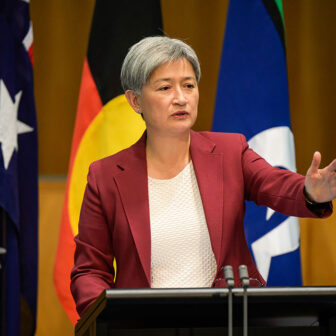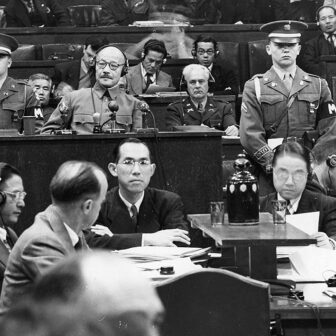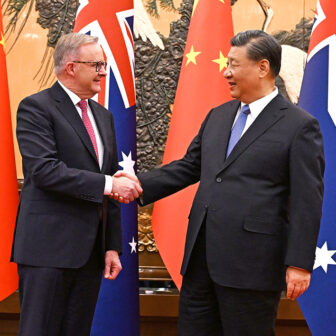For decades, successive Australian governments have recognised that Asia holds the key to our nation’s economic prosperity and security. Australia has built up massive trading relationships with Asian countries, invested hugely in diplomatic relationships in the region (our largest embassy is in Jakarta rather than Washington) and developed major programs to encourage educational and cultural ties. Federal governments routinely proclaim the importance of Asia to Australia’s future, most recently in the 2016 defence and 2017 foreign policy white papers.
Yet, in the midst of a global pandemic that originated in the region, and at a time when China’s rise is shaking geopolitical certainties throughout the world, one of our major national institutions has decided to turn away from Asia. Ironically, the same institution was a pioneer of Asian engagement.
For almost seven decades, the National Library of Australia has been building one of the world’s most extensive collections of Southeast and Northeast Asian material. The legacy of accumulated investment and collecting by specialist curators, its store of Asian newspapers and periodicals, books, government documents and other rare materials is among the great treasure troves of Asian studies, and the most extensive Asia collection in the southern hemisphere. Researchers visit from around the world, and the collection is a foundation stone of decades of effort to build sustained and deep knowledge of Asia at Australian universities.
Now, much of this is to be abandoned. In a new “collection development policy” — the document that lays out what and how the library will collect — the library has dramatically downgraded its emphasis on overseas collecting. It has removed key Asian countries from its list of priorities; it has closed its Asian Collections Room; it has cancelled subscriptions to hundreds of Asian periodicals.
Several specialist librarians with Asian language skills — crucial for managing existing holdings to say nothing of extending them — have recently retired and not been replaced, or have been replaced at a lower level. The future of current specialist staff working on Asian language collections is in doubt. Though the library maintains it will still prioritise three Asian countries — China, Indonesia and Timor-Leste — signs suggest that this collecting will be severely downgraded.
As its own website explains, the National Library has been developing its Asia collections since the 1950s. They are a legacy of the Menzies era when, learning from the deadly experience of the second world war, Australia’s federal government decided it needed to build deeper knowledge of the region in which Australia is located. Even as the White Australia policy continued to restrict Asian immigration, the library began to collect materials from Asian countries and in Asian languages. It was thus the forerunner of a broader Asian turn that followed in other Australian institutions, including universities, schools and, eventually, the private sector.
Even as the vision of Australian engagement with Asia has waxed and waned at the federal level down the years, the library has kept its eyes firmly fixed on the region. It has built up a rich collection, including — in the case of many of the Southeast Asian collections, as well as the remarkable North Korean collection — newspapers, political documents and other materials that are now difficult if not impossible to obtain in those countries.
The new collection development policy makes it clear that the library is turning inward, sharpening the focus on Australian materials. Thankfully, the Asia-Pacific will remain the priority in overseas collecting, but the scope of the reduction leaves only part of the previous Asia strategy intact. Countries that have been a major focus for decades — notably Japan and Korea, and also all the countries of mainland Southeast Asia — have been dropped altogether from the list of priority countries for collecting. Collections that have been developed over decades will now wither on the vine of neglect.
From a national interest perspective, this makes little sense. Of course, Australian collections must be the centrepiece of Australia’s national library. But if we accept that Australia’s fate is inextricably linked to our region — as all Australian governments since Menzies have believed — then we must recognise that knowledge of the region is important too. Understanding Australia requires that we understand our Asian context. This is the approach that has guided the library in the past.
Nothing in the external environment has changed. Asia has become more not less important to Australia: note, for example, that two of the countries just dropped as priorities (Korea and Japan) were among the top four trading partners of Australia last year. One of the digital subscriptions cancelled by the library covered local newspapers throughout China, including in Hubei province, the epicentre of the Covid-19 pandemic.
Given this context, and with so many sunk costs in an Asia collection that rivals the best in the world, why walk away now? The main reason is depressingly familiar: funding cuts. Many years of “efficiency dividends,” as well as major cuts under prime minister Tony Abbott, have severely curtailed the library’s budget. It now barely has enough money to manage basic functions such as providing shelf storage for its constantly growing collection or maintaining its ageing ventilation systems. The shift to digitisation has placed new pressures on the library’s budget, which it has been able to cover only partly with special purpose grants (which don’t fix the underlying problem).
The decline in base funding has been relentless. According to my calculations using data in the library’s annual reports, it experienced roughly a 15 per cent cut in government income (adjusted for inflation) in the years between 2009–10 and 2017–18 alone. (Take out a special grant for a Captain Cook exhibition held in 2018 and the decline is even steeper.) In the same period the population of Australia grew by 14 per cent, further increasing the library’s domestic collecting burden, but the number of library staff fell by 20 per cent, from about 500 to 400.
No institution can survive cuts like this without paring back basic programming. Something had to give. Given the library is statutorily obliged to build an Australian collection, it decided the deepest cuts would be in overseas collecting, of which the Asia-Pacific has always been a major component.
Government spending is an expression of political priorities, of course, and the library has obviously lacked effective champions in government. This becomes clear when we realise that not all of the national cultural institutions have suffered in the same way. In 2018, for example, the government announced a funding boost of $498 million to redevelop the Australian War Memorial. Where there is political will, funding can be found.
The irony in all of this is that the federal government remains rhetorically committed to building Asia knowledge. Government documents proclaim that Australia needs to promote its “soft power” in the region, in part by demonstrating seriousness about Asia. A National Library that is increasingly inward-looking points in exactly the opposite direction. •




